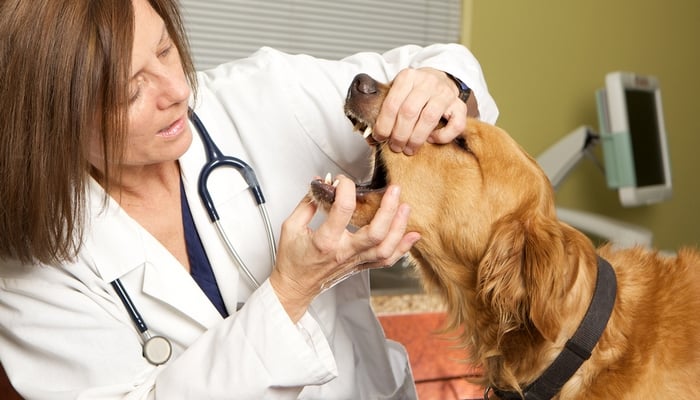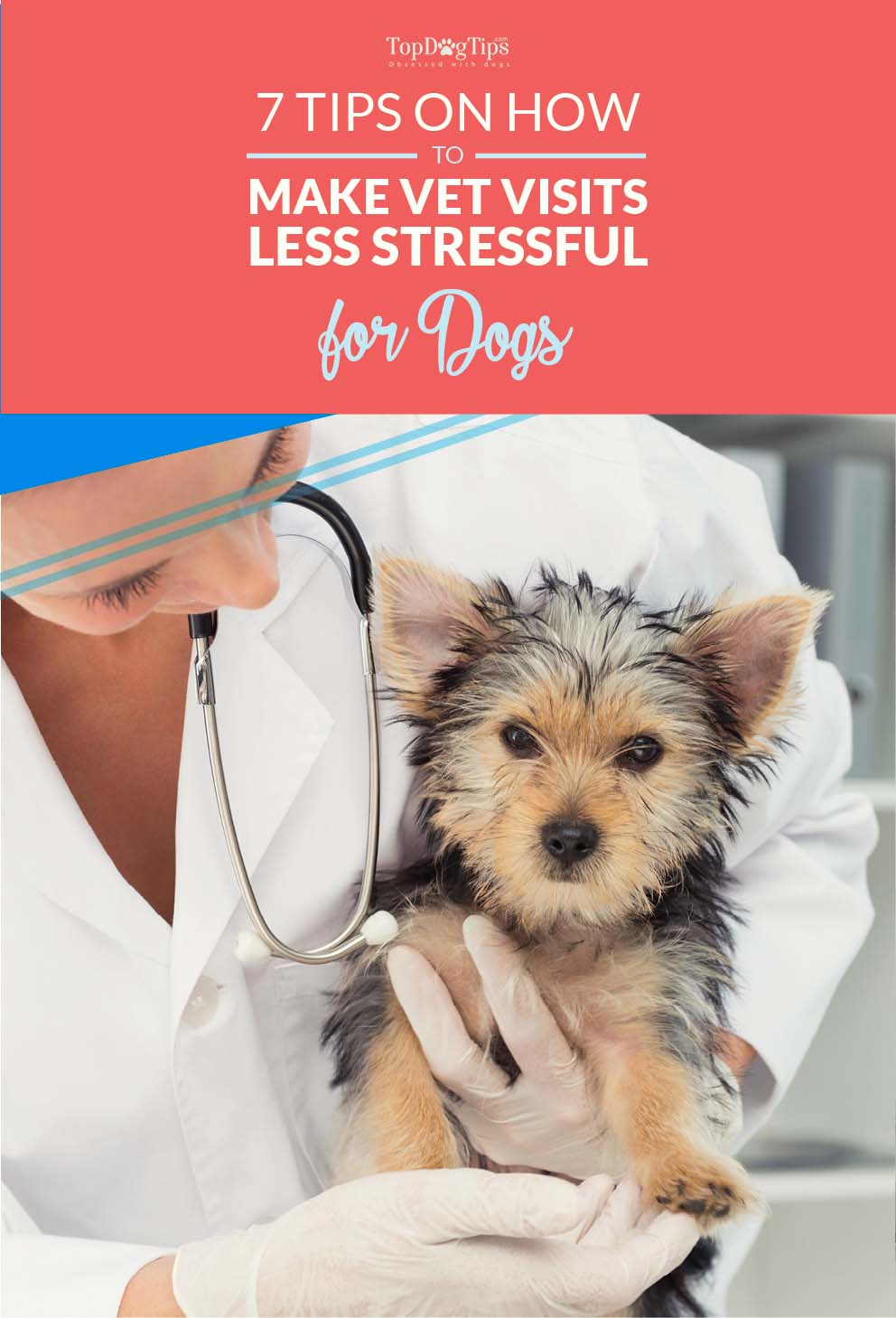If your dog enjoys going to the vet, don't take that for granted. You're one of the few pet parents who won the lottery and do not have to drag your canine companion in through the door or coax him with dog treats just to get your Fido in the car.
A lot of dogs have serious anxiety about going to the vet. In this article, I'm bringing you seven great tips for making vet visits less stressful from experts. Using these you'll be able to help your Fido understand that the vet's office is nothing to get worked up about.
Dogs are smart. They know when we're trying to trick them. You may be able to get Fido into his carrier easily the first couple of times, but after he realizes that he only rides in the carrier on his way to the vet, you'll have a hard time ever getting him into it again. Making vet visits less stressful will take proper planning, time and patience.
According to Companion Animal Psychology, 30% of dogs are highly stressed while sitting in the waiting room at the vet's office. And why wouldn't they be? It's a new environment that smells like a bunch of animals, there are new people coming in and out and they are unsure of what is going on.
Not to mention, if your dog has had a negative experience at the vet, he'll make the connection and be even more nervous about waiting his turn to enter the exam room.
I've read numerous articles this week from trusted sources to find the best tips for making vet visits less stressful. I encourage you to read the articles yourself, but I've picked the top 7 tips to share with you here. If you have any additional tips to add, please leave a comment below to share them with other readers.
READ ALSO: 18 Tips on How to Save Money on Vet Bills and Meds
7 Tips for Making Vet Visits Less Stressful
 1. Companion Animal Psychology
1. Companion Animal Psychology
Along with their statistics on canine anxiety, this website also shares some interesting tips for making vet visits less stressful. The first thing you need to remember is not to make the vet the only place that you take your dog. If you only take him in the car when it's time to go to the vet, he's going to catch on very quickly.
Even if it's just a quick trip to the post office, take your pet with you in the car regularly. If he goes for a ride with you a few times each month, he won't know the difference when it comes time to go to the vet.
- …don’t only go for car rides when you’re going to an appointment; make sure your dog has fun outings too, to go for walks or accompany you on errands. That way the car doesn’t predict bad stuff.
2. One Green Planet
The next thing you need to remember is that your dog can sense your emotions. If you get nervous and anxious when it's time to go to the vet, he's going to feed off of your emotions. Your stress will add to his stress and things will only get worse. As One Green Planet suggests in this article, you need to stay calm if you want Fido to stay calm.
- Take a deep breath and STAY CALM! Your animal will likely sense your tension and become stressed as well. We’ve viewed the research in regards to animal companions having the ability to lower human stress when people are in need of help. So let’s do our animal friends a favor and help lower their stress when it’s their turn for healthcare.
3. Advice from Pets-N-More
Now, let's talk about how you're going to get your dog into the vet's office. If your goal is making vet visits less stressful, you need to make sure your pet is used to the method that you'll be using to get him through the door. If you're going to use a carrier, make sure he has plenty of time to get used to it before the first trip to the vet, and don't use the carrier strictly for vet visits.
Much like the car, if you only use a carrier to take your dog to the vet, he'll quickly catch on and you'll have a hard time getting him to go inside the carrier. Likewise, if you'll be walking your dog with a leash and harness/collar, make sure he's properly leash trained before you take him to the vet. Pets-N-More has this to say about preparing your pet for the visit:
- If you do not plan on using a pet carrier for transport, train your dog to walk on a leash. A shorter leash or halter is best in this situation as it provides more control for the dog owner and prevents tangling with other animals or furniture. Leashes also provide a handhold for cases where aggressive behaviors among animals might otherwise get out of control.
4. MyGermanShepherd.org explains the “DIY exam”
Making vet visits less stressful will be much easier if your dog knows what to expect. I've never thought to give a dog a “DIY exam” at home, but this blog post on MyGermanShepherd.org explains the positive impact that this quick activity can have on your dog's comfort level. It also includes a great diagram of the simple things you can do to simulate a basic veterinary exam.
- What I mean with this is: Although you are not the vet, perform a theater play of being the vet. Do a full body check of your dog, similarto what the vet will do on the day of the appointment. Do make your DIY vet visits a special occasion, let your dog feel that the full body examination is something special. Sort of a treat at a certain point in time, on a certain day. Be totally calm before, during, and after this exam treat.
5. Tips from The Whole Dog Journal
Did you know that most veterinarian's are happy to have your pet stop by just to say “hello?” Taking your dog for a quick and fun visit is one of the best ways to make veterinary care less stressful for him. You don't want your dog to associate the vet's office with neutering, regular shots and having blood drawn.
As this article from The Whole Dog Journal explains, stopping by to say “hi” to the vet is a great way for your dog to have regular positive experiences at the vet's office.
- New places are sometimes anxiety producing – just because they are new. Stopping by occasionally reduces your dog’s anxiety by simply transforming the vet’s office from an unknown to a known environment.
6. VetStreet says bribery can work well
What dog isn't motivated by food? There are a select few, but for the most part dogs love treats, and you can use healthy snacks to help your dog feel more comfortable at the vet. As this blog post on vetstreet.com explains, if your dog is hungry when you go to the vet, he's likely to focus on the treats that you bring. This will help to take his mind off the impending examination.
- And speaking of cookies, take treats but make sure your pet is hungry enough to want them. It won’t kill your pet to skip the meal before a veterinary visit, but it will make the treats you’ll have at the hospital seem even more delicious. Bring on the really yummy, juicy, meaty treats, such as baby-food meat sticks, deli turkey or bonita flakes for cats.
7. Good Housekeeping has some pointers too
Making vet visits less stressful is such a hot topic that even Good Housekeeping is offering up advice. In this article they explain that the use of anti-anxiety wraps and scents may be very beneficial to dogs who become stressed when going to the vet. These products are easy to find both online and in retail stores.
- Help ease your animal’s anxiety with a pacifying scent or wrap. Lavender essence, for instance, may help soothe canines. You can also dress your pup in an anti-anxiety garment, such as the Thundershirt, as “feeling swaddled can calm them,” Stilwell says.
Hopefully these tips were useful and the next time you have to take your dog to the vet, you'll have an easier time with him.
However, if your dog(s) stress about visiting the vet anyway and the anxiety is severe, you may need to look into this further. You can find more information about treatments in our articles on anti-anxiety vests and anxiety medications for dogs.
READ NEXT: 10 Tips On How to Calm Down a Dog













